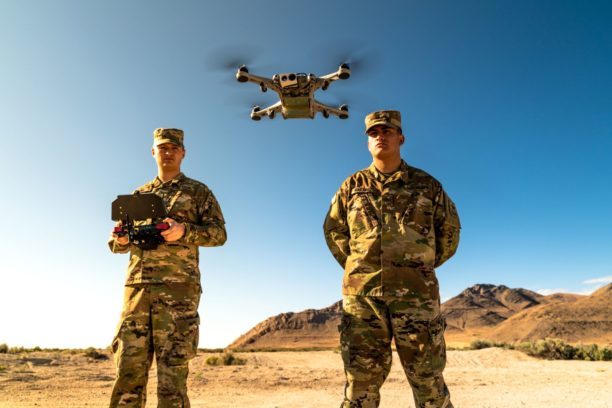After successful U.S. Army testing of Apium’s swarm autopilot on the Teal 2 platform, the partnership with Red Cat aims to bring next-generation swarm capability to the tactical edge.
The U.S. drone and robotics companies Apium Swarm Robotics, Inc. (Apium) and Red Cat Holdings, Inc. (Red Cat) have announced a new partnership. On 4 November 2025 they signed a Memorandum of Agreement (MOA) under which Apium will join Red Cat’s “Futures Initiative” consortium. The goal: accelerate the deployment of advanced, interoperable unmanned systems (UxS) that can play a role in defence and national security operations.
The announcement follows successful testing in which Apium’s swarm-autopilot and ground control system were integrated into Red Cat’s Teal 2 drone platform and demonstrated at the U.S. Army’s ACM-UAS Industry Day at Fort Rucker, Alabama. That demonstration highlighted the value of decentralised, scalable drone swarming in contested environments.
Apium’s approach shifts the “swarm logic” from a central ground station to the drones themselves. Each vehicle can cooperate with its neighbours, make independent decisions, and continue the mission even if ground control is lost or some drones fail. According to Apium’s Founder and Chief Scientist, Tyler MacCready, “One to Many swarming is the future of autonomous warfare… Our technology allows full swarm capability to be added to existing ‘off-the-shelf’ multi-domain UxS…” The system is designed so a single operator can launch, command, or adapt the swarm in real time, without complex pre-mission planning or a constant uplink.


Jason Gunter, Director of Special Programs at Red Cat and leader of the Futures Initiative, described the milestone as “a major leap forward for tactical autonomy… the exact capability our warfighters need in complex, contested environments.” The partnership aims to integrate Apium’s swarm-enabled platform across Red Cat’s family of systems (led by the Black Widow™) and supports Red Cat’s strategic goal to move faster to market through best-of-breed development partnerships.
Why This Technology is Different
-
Resiliency and autonomy: By embedding decision-making in each drone, swarms can continue to operate even when communications are degraded or the ground station is compromised. That kind of resilience is critical in contested battlespaces.
-
Scalability: Since control is decentralised, larger swarms (many drones acting in concert) become more feasible without overwhelming the operator or infrastructure.
-
Tactical edge deployment: The move from lab demonstration to real-world tactical drone operations signals that autonomous swarming is moving closer to operational deployment rather than remaining purely theoretical.
Background on Red Cat and Teal Drones
Red Cat is a U.S.-based provider of advanced all-domain drone and robotic solutions for defense and national security. Red Cat has adopted a “best-of-breed” partnership approach—actively signing MOAs and teaming with autonomy, AI, computer vision and robotics firms in order to speed development and fielding. For example, Red Cat partnered with Palladyne AI Corp. to demonstrate autonomous multi-drone collaboration across heterogeneous platforms.
Red Cat’s subsidiary Teal Drones (formerly independent) was selected by the U.S. Army for the Short Range Reconnaissance (SRR) Program of Record to deliver thousands of lightweight, portable drones including the Black Widow system. Earlier in 2022, Red Cat reported it had developed and marketed a fully operational multi-drone (4-ship) system via Teal, enabling one operator to control multiple drones simultaneously.
By partnering with best-in-class autonomy firms like Apium, Red Cat is positioning itself to deliver not just hardware, but swarms of smart, interoperable platforms for the tactical edge.
What’s next
Under the agreement, Apium will work with Red Cat to integrate its swarm-enabled autopilot and ground control into the entirety of Red Cat’s Family of Systems (including Black Widow). Apium’s platform is autopilot-agnostic and compatible with common systems such as PX4 and ArduPilot, supporting rapid integration across current and future assets.
For drone and robotics professionals, the partnership signals that swarming autonomy is no longer just a research topic, it’s moving into defence production pathways. Operators should expect incremental roll-outs of swarm-capable platforms in the coming years, initially at the platoon or company level in tactical scenarios where communication may be degraded or denied.
The MOA between Apium and Red Cat marks another important step in the evolution of autonomous unmanned systems for defence. The ability to field swarms of collaborating drones that can adapt on the fly, self-organise, and operate without constant human micromanagement aligns with rising military priorities for resilient, scalable systems. For Red Cat, the deal reinforces its strategy of partnering widely to accelerate delivery of advanced capabilities, while Apium gains a strong platform and customer base for its distributed-autonomy technology.
Read more:


Miriam McNabb is the Editor-in-Chief of DRONELIFE and CEO of JobForDrones, a professional drone services marketplace, and a fascinated observer of the emerging drone industry and the regulatory environment for drones. Miriam has penned over 3,000 articles focused on the commercial drone space and is an international speaker and recognized figure in the industry. Miriam has a degree from the University of Chicago and over 20 years of experience in high tech sales and marketing for new technologies.
For drone industry consulting or writing, Email Miriam.
TWITTER:@spaldingbarker
Subscribe to DroneLife here.


